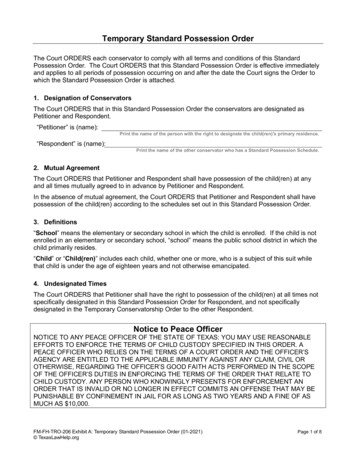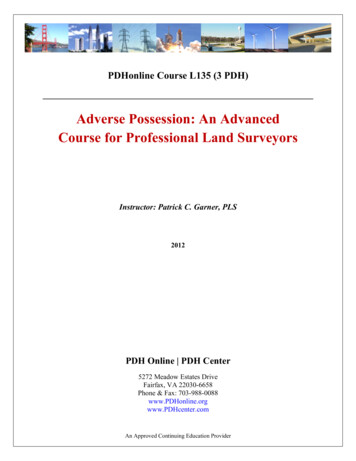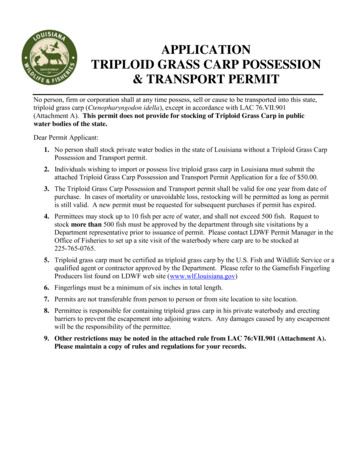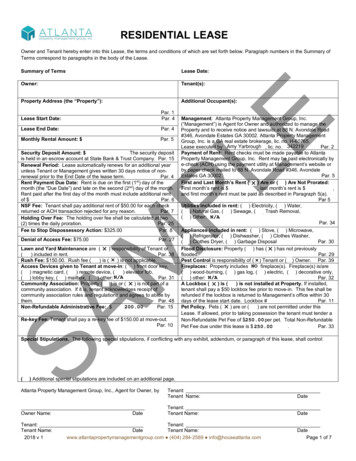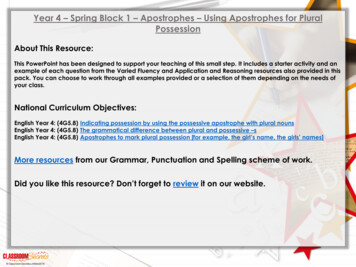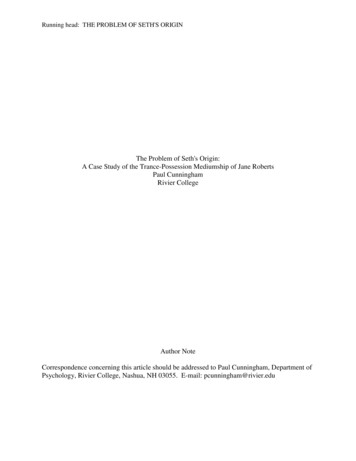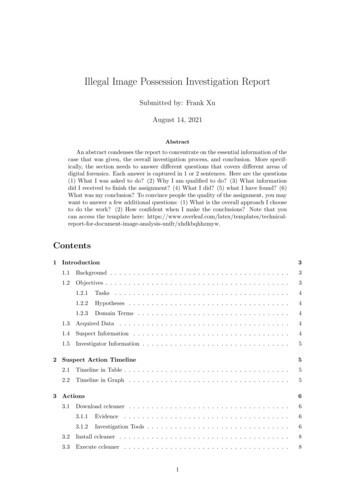
Transcription
Illegal Image Possession Investigation ReportSubmitted by: Frank XuAugust 14, 2021AbstractAn abstract condenses the report to concentrate on the essential information of thecase that was given, the overall investigation process, and conclusion. More specifically, the section needs to answer different questions that covers different areas ofdigital forensics. Each answer is captured in 1 or 2 sentences. Here are the questions(1) What I was asked to do? (2) Why I am qualified to do? (3) What informationdid I received to finish the assignment? (4) What I did? (5) what I have found? (6)What was my conclusion? To convince people the quality of the assignment, you maywant to answer a few additional questions: (1) What is the overall approach I chooseto do the work? (2) How confident when I make the conclusions? Note that youcan access the template here: myw.Contents1 Introduction31.1Background . . . . . . . . . . . . . . . . . . . . . . . . . . . . . . . . . . . . . . .31.2Objectives . . . . . . . . . . . . . . . . . . . . . . . . . . . . . . . . . . . . . . . .31.2.1Tasks . . . . . . . . . . . . . . . . . . . . . . . . . . . . . . . . . . . . . .41.2.2Hypotheses . . . . . . . . . . . . . . . . . . . . . . . . . . . . . . . . . . .41.2.3Domain Terms . . . . . . . . . . . . . . . . . . . . . . . . . . . . . . . . .41.3Acquired Data . . . . . . . . . . . . . . . . . . . . . . . . . . . . . . . . . . . . .41.4Suspect Information . . . . . . . . . . . . . . . . . . . . . . . . . . . . . . . . . .41.5Investigator Information . . . . . . . . . . . . . . . . . . . . . . . . . . . . . . . .52 Suspect Action Timeline52.1Timeline in Table . . . . . . . . . . . . . . . . . . . . . . . . . . . . . . . . . . . .52.2Timeline in Graph . . . . . . . . . . . . . . . . . . . . . . . . . . . . . . . . . . .53 Actions3.16Download ccleaner . . . . . . . . . . . . . . . . . . . . . . . . . . . . . . . . . . .63.1.1Evidence . . . . . . . . . . . . . . . . . . . . . . . . . . . . . . . . . . . .63.1.2Investigation Tools . . . . . . . . . . . . . . . . . . . . . . . . . . . . . . .63.2Install ccleaner . . . . . . . . . . . . . . . . . . . . . . . . . . . . . . . . . . . . .83.3Execute ccleaner . . . . . . . . . . . . . . . . . . . . . . . . . . . . . . . . . . . .81
3.4Delete ccleaner . . . . . . . . . . . . . . . . . . . . . . . . . . . . . . . . . . . . .84 Investigator Activity logs85 Conclusion85.1Task Check List . . . . . . . . . . . . . . . . . . . . . . . . . . . . . . . . . . . . .95.2Hypothesis Check List . . . . . . . . . . . . . . . . . . . . . . . . . . . . . . . . .9Appendices10ADisk Images . . . . . . . . . . . . . . . . . . . . . . . . . . . . . . . . . . . . . . .10BProvided Documents . . . . . . . . . . . . . . . . . . . . . . . . . . . . . . . . . .10CEvidence Extracted from rhino.log . . . . . . . . . . . . . . . . . . . . . . . . . .10DEvidence Extracted from rhino2.log . . . . . . . . . . . . . . . . . . . . . . . . . .10EEvidence Extracted from rhino3.log . . . . . . . . . . . . . . . . . . . . . . . . . .102
1Introduction1.1Background‘Iaman Informant’ was working as a manager of the technology development division at a famousinternational company OOO that developed state-of-the-art technologies and gadgets.One day, at a place which ‘Mr. Informant’ visited on business, he received an offer from ‘SpyConspirator’ to leak of sensitive information related to the newest technology. Actually, ‘Mr.Conspirator’ was an employee of a rival company, and ‘Mr. Informant’ decided to accept theoffer for large amounts of money, and began establishing a detailed leakage plan.‘Mr. Informant’ made a deliberate effort to hide the leakage plan. He discussed it with ‘Mr. Conspirator’ using an e-mail service like a business relationship. He also sent samples of confidentialinformation though personal cloud storage.After receiving the sample data, ‘Mr. Conspirator’ asked for the direct delivery of storage devicesthat stored the remaining (large amounts of) data. Eventually, ‘Mr. Informant’ tried to takehis storage devices away, but he and his devices were detected at the security checkpoint of thecompany. And he was suspected of leaking the company data.At the security checkpoint, although his devices (a USB memory stick and a CD) were brieflychecked (protected with portable write blockers), there was no evidence of any leakage. Andthen, they were immediately transferred to the digital forensics laboratory for further analysis.The information security policies in the company include the following: Confidential electronic files1 should be stored and kept in the authorized external storagedevices and the secured network drives. Confidential paper documents and electronic files can be accessed only within the allowedtime range from 10:00 AM to 16:00 PM with the appropriate permissions. Non-authorized electronic devices such as laptops, portable storages, and smart devicescannot be carried onto the company.Non-authorized electronic devices such as laptops,portable storages, and smart devices cannot be carried onto the company. All employees are required to pass through the ‘Security Checkpoint’ system. All storage devices such as HDD, SSD, USB memory stick, and CD/DVD are forbiddenunder the ‘Security Checkpoint’ rules.In addition, although the company managed separate internal and external networks and usedDRM(Digital Rights Management) / DLP (Data Loss Prevention) solutions for their informationsecurity, ‘Mr. Informant’ had sufficient authority to bypass them. He was also very interestedin IT (Information Technology), and had a slight knowledge of digital forensics.Note that the case description is from https://www.cfreds.nist.gov/data leakage case/data-leakagecase.html. If you use any references, please pay attention to the reference format. Here are twocitation examples, including Long Short-Term Memory (LSTM) [1] and Graph Neural Networks(GNN)[3].1.2ObjectivesThis section specifies what are you being asked to do. You will include your hypothesis here. Itis especially important to include if you were asked to perform a targeted investigation. Also agood idea to include any specific search terms requested.3
1.2.1TasksList what are you being asked to here: Task 1: XXX Task 2: XXX Task 3: XXX1.2.2HypothesesList hypotheses here: Hypothesis 1: XXX Hypothesis 2: XXX Hypothesis 3: XXX1.2.3Domain TermsList term in the domain. We need define domain related terms, e.g., terms used when weinvestigate a fraud related to accounting. Accounts payable: fill out the definition here. Accounts receivable: fill out the definition here. Certified public accountant: fill out the definition here.1.3Acquired DataThe subsection describes What information I received to finish the assignment beside backgroundinformation. It focuses on disk images and files that are associate with the crime case. Fig. 1show one DD image. Although not all attributes are required, you may want to provide as muchinformation as possible. You HAVE TO add more attributes as needed. The same principleapplies to other tables.Table 1: DD imageAttributeFilenameMD5SHA-1Imaging SoftwareTotal SizeAcquired onAcquired byDescription1.4Detailed Informationcfreds 2015 data leakage 47A8A9856B1371C2384D44FD785FTK Imager 3.4.0.120.00 GB (21,474,836,480 bytes)2016-01-20T12:31:00.000ZNISTThis is the DD image created in crime sceneSuspect InformationTable. 2 shows suspect’s information. Although not all attributes are required, you may wantto provide as much information as possible.4
Table 2: Suspect InformationAttributenameDetailed InformationIaman Informantthreat actor 1.5DescriptionA name used to identify this Threat Actor or Threat Actor group.The type(s) of this threat actor. Thevalues for this property SHOULD comefrom the threat-actor-type-ov open vocabulary.The skill, specific knowledge, specialtraining, or expertise a Threat Actormust have to perform the attack. Thevalue for this property SHOULD comefrom the threat-actor-sophistication-ovopen vocabulary.Investigator InformationExplain Why I am qualified to do? Table. 2 shows suspect’s information. Although not allattributes are required, you may want to provide as much information as possible.Table 3: Investigator InformationAttributenameDetailed InformationFrank XucertificatesCertified forensic examinerhas investigated case refsNIST data leakage case2DescriptionA name used to identify this Investigator.Specifies a list of certificates the investigator has.Specifier a list of x-crime-case.Suspect Action Timeline2.1Timeline in TableThis section describes what I have found. I organized my findings in terms of actions performedby the suspect in a chronological order. Table. 4 show the format of the timeline for the reconstructed crime case. A timeline object describes a specific cybercrime case that is representedby a sequence of actions performed by a threat actor in chronological order. Please don’t addany activities of investigators here.Table 4: Reconstructed Timeline of Illegal Image Procession ndownload ccleaner software.install ccleaner software.execute ccleaner software.delete ccleaner softwareTimeline in GraphFigure 1 shows the graphical timeline of the Data Leakage scenario. Sometime, the graphictimeline helps readers to understand the reconstructed scenario.5
Figure 1: Graphical Timeline of the Data Leakage Scenario3ActionsThis section describes each action performed by the suspect. Make sure actions are consistentwith the all actions in the timeline aforementioned.3.13.1.1Download ccleanerEvidenceList all supporting evidence that indicates the suspect downloaded software or files. For eachevidence, using an appropriate table to describe the attributes and value of the evidence. Download process. The process that downloads a file. The attributes and values of theprocess is shown in Table 5. Downloaded file. The file was downloaded by the process. The attributes and values ofthe process is shown in Table 6.Note that we often want to show discovered evidence in graph. Therefore, we attach the downloadfile in Fig. 23.1.2Investigation ToolsList all tools that are used for extracting evidence, such as the tool that is used to show downloading process and tool that is used for find downloaded files. Create a table to describe theattributes and values of the tool. See Wireshark as an example. Wireshark: For extracting process information. The attributes and values of the tool thatis used to show pid is shown in Table 7. Regripper: Describe the tool here. Create a table. See Wireshark as an example. WInHex: Describe the tool here. Create a table. See Wireshark as an example.6
Table 5: Download ProcessAttributepidDetailed Information314created time2016-01-20T14:11:25.55Zcommand line./gedit-bin –new-windowimage reffirefox.exeDescriptionSpecifies the Process ID, or PID, of theprocess.Specifies the date/time at which theprocess was created.Specifies the full command line usedin executing the process, including theprocess name (which may be specified individually via the image ref.nameproperty) and any arguments.Specifies the executable binary that wasexecuted as the process image, as a reference to a File object. The object referenced in this property MUST be oftype file.Table 6: Downloaded ccleanerAttributenameMD-5Detailed 7a74size56653DescriptionSpecifies the name of the file.Specifies the date/time at which theprocess was created.Specifies the size of the file, in bytes.Table 7: Investigation Tool: WiresharkAttributenamedescriptioninputs refsDetailed InformationwiresharkWireshark is a free and open-sourcepacket analyzer. It is used for networktroubleshooting, analysis, software andcommunications protocol development,and education.log.pcapoutputs refspid3553, ccsetup.exeversion3.4.5DescriptionA short name of the investigation tool.A description that provides more details and context about the investigation tool.Specifies a list of function inputs. ItShould come from any STIX objects orCFOs.Specifies a list of function outputs orpartial outputs. It Should come fromany objects that an Observed Data references to.The version identifier associated withthe investigation tool.Figure 2: ccleaner installer7
3.2Install ccleanerSame as previous subsection.3.3Execute ccleanerSame as previous subsection.3.4Delete ccleanerSame as previous subsection.4Investigator Activity logsThe section describes what you did during the investigation. You must record your interactionwith the digital evidence and the steps taken to preserve and forensically acquire the evidence.Any activities that you perform (e.g. forensically wiping storage/examination media, etc.)should be notated in this section of your report. The logs ensure the integrity of the digitalevidence and your chain of custody. Here are some sample logs [2]: On today’s date, Detective Max Fox contacted the UB Forensics Laboratory in regardsto extracting data from Google Pixel 4XL that had been recovered from a crime scene.Detective Max is requesting a forensic examination to see what information by the suspectmay have been deleted. He is requesting a full forensic examination and report for possiblecriminal charges. On today’s date I began the forensic acquisition/imaging process of the stolen laptop. Priorto imaging the stolen laptop, I photographed the laptop, documenting any identifiers (e.g.,make, model, serial #), unique markings, visible damage, etc. while maintaining chain ofcustody. Using a sterile storage media (examination medium) that had been previously forensicallywiped and verified by this examiner (MD5 hash value: ed6be165b631918f3cca01eccad378dd)using ABC tool version 1.0. The MD5 hash value for the examination medium yielded thesame MD5 hash value as previous forensic wipes to sterilize this media. At this point, I removed the hard drive from the stolen laptop and connected it to myhardware write-blocker, which is running the most recent firmware and has been verifiedby this examiner. After connecting the hardware write blocker to the suspect hard drive,I connected the hardware write blocker via USB 2.0 to my forensic examination machineto begin the forensic imaging process? Etc, etc.5ConclusionThe section summarize the case. Here is an example from 12/CSI Investigation.pdf.You mainly focus on two check lists, including the task and hypothesis check lists, which youhave described in the introduction section?8
5.1Task Check ListHave you completed the tasks you described in introduction section? Task 1: XXX Task 2: XXX Task 3: XXX5.2Hypothesis Check ListAre your hypotheses true or false? Hypothesis 1: XXX Hypothesis 2: XXX Hypothesis 3: XXXIn conclusion, Ian has used stenography and password protection techniques to hide evidencefrom investigators. Ten unique illegal rhino images were recovered from network traffic logs. During the investigation, several software tools are used for extracting evidence, including Wiresharkand WinHex.9
AppendicesADisk ImagesBProvided DocumentsCEvidence Extracted from rhino.logDEvidence Extracted from rhino2.logEEvidence Extracted from rhino3.log10
References[1] Sepp Hochreiter and Jürgen Schmidhuber. Long short-term memory. Neural Computation,9(8):1735–1780, 1997.[2] Bill Nelson, Amelia Phillips, and Christopher Steuart. Guide to computer forensics andinvestigations. Cengage Learning, 2014.[3] A. Sperduti and A. Starita. Supervised neural networks for the classification of structures.IEEE Transactions on Neural Networks, 8(3):714–735, 1997.11
certi cates Certi ed forensic examiner Speci es a list of certi cates the inves-tigator has. has investigated case refs NIST data leakage case Speci er a list of x-crime-case. 2 Suspect Action Timeline 2.1 Timeline in Table This section describes what I have found. I organized my ndings in terms of actions performed

